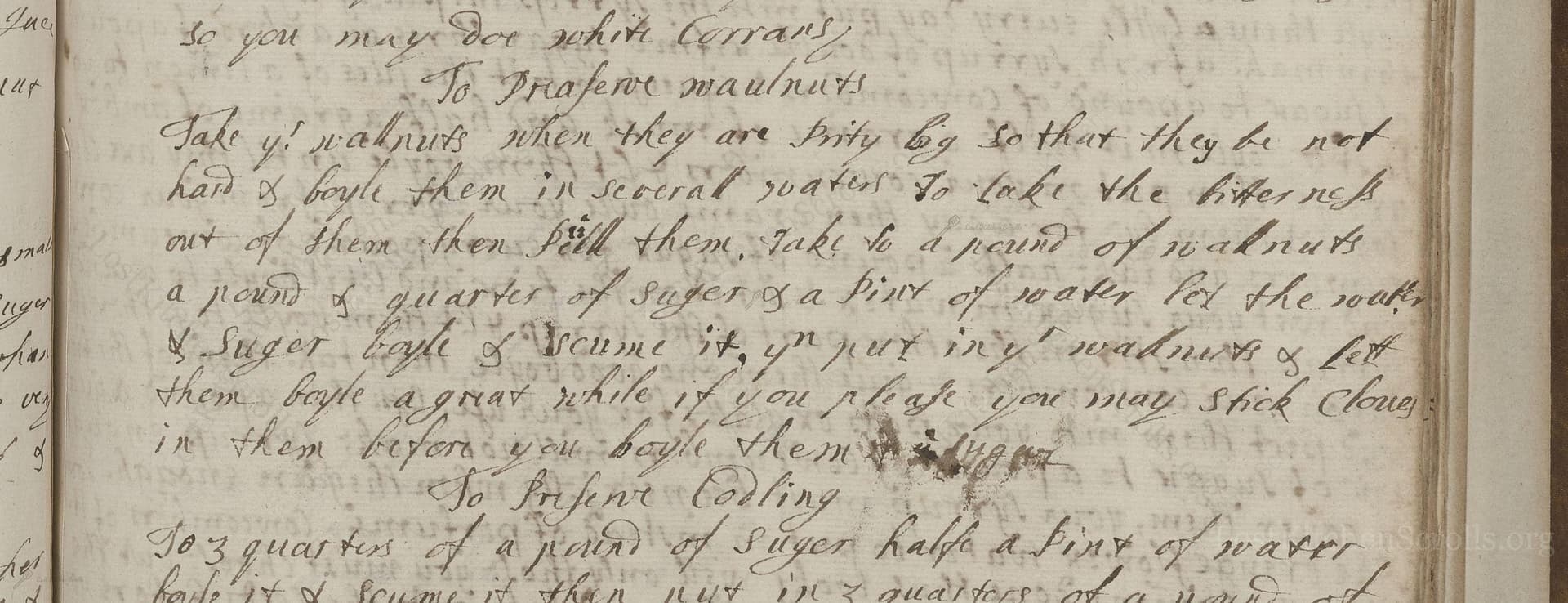To Preserve Walnuts
From the treasured pages of Receipts in cookery and medicine 1700
Unknown Author

To Preserve Walnuts
"Take yr walnuts when they are prickt by so that they be not hard & boyle them in several waters to take the bitternes out of them then fill them, take to a pound of walnuts a pound & quarter of suger & a pint of water let the water & Suger boyle & Scume it, yn put in yr walnuts & let them boyle a great while if you please you may stick Cloves in them before you boyle them."
Note on the Original Text
The recipe is written in the terse, instruction-heavy style of early modern English cookery, assuming a base level of kitchen knowledge. Spelling and grammar vary, with little standardization ('boyle' for 'boil', 'Scume' for 'skim', 'Suger' for 'sugar'). Quantities are given in pounds and pints, which have been converted to metric, though the text allows flexibility ('if you please'). The layering of steps and lack of exact timings reflect the oral culinary tradition of the time.

Title
Receipts in cookery and medicine 1700 (1700)
You can also click the book image above to peruse the original tome
Writer
Unknown
Era
1700
Publisher
Unknown
Background
Step into the kitchen of the early 18th century, where this charming culinary manuscript tempts tastebuds with recipes and secrets from a bygone era. A delicious journey for both the curious cook and the history lover.
Kindly made available by
Folger Shakespeare Library
This recipe is drawn from an early 18th-century English manuscript, showcasing the methods households used to preserve seasonal produce well before refrigeration. Walnuts were prized in the kitchen for their unique, complex flavor, and preserving them in sugar syrup provided a sweet treat and an ingredient for both savory and sweet dishes throughout the year. The manuscript reference 'V.b.273' notes its origin around 1700, a period when recipe collections often circulated in handwritten books among households, passing down and adapting culinary wisdom.

Cooks in 1700 would have used a hearth or open fire and robust iron or copper pots for boiling. Wooden spoons and ladles were common for stirring. For pricking walnuts, a knitting needle or long pin would suffice. Skimming off the foam from the sugar syrup was likely done with a large spoon or small skimmer. For storage, glass jars were rare but possible in wealthier homes; otherwise, ceramic or earthenware jars sealed with parchment or leather were used.
Prep Time
12 hrs
Cook Time
1 hr
Servings
10
We've done our best to adapt this historical recipe for modern kitchens, but some details may still need refinement. We warmly welcome feedback from fellow cooks and culinary historians — your insights support the entire community!
Ingredients
- 1 lb 2 oz young, green walnuts (pricked to test for tenderness)
- 1 lb 3.4 oz white granulated sugar
- 2 cups water
- Whole cloves (optional, about 8–12 pieces)
Instructions
- Begin by selecting young, green walnuts – they should be pierced easily with a needle or skewer, indicating they aren’t yet hard.
- Bring a pot of water to a boil, add the walnuts, and boil them briefly.
- Drain, then repeat this boiling and draining process with fresh water several times to remove their natural bitterness.
- Once done, drain well.
- For each 1 lb 2 oz of prepared walnuts, measure out 1 lb 3.4 oz of sugar and 2 cups of water.
- In a saucepan, combine sugar and water and bring to a rolling boil, skimming off any foam that rises to the surface.
- If desired, stud the walnuts with cloves before the next step.
- Add the drained walnuts to the syrup and simmer gently until the nuts are well-saturated with the syrup and glossy.
- Cool and store in sterilized jars.
Estimated Calories
130 per serving
Cooking Estimates
It takes time to prepare the walnuts by boiling and draining them several times to remove bitterness, then simmering them in syrup. Each serving has about 130 calories, and this recipe makes 10 servings.
As noted above, we have made our best effort to translate and adapt this historical recipe for modern kitchens, taking into account ingredients nowadays, cooking techniques, measurements, and so on. However, historical recipes often contain assumptions that require interpretation.
We'd love for anyone to help improve these adaptations. Community contributions are highly welcome. If you have suggestions, corrections, or cooking tips based on your experience with this recipe, please share them below.
Join the Discussion
Rate This Recipe
Dietary Preference
Main Ingredients
Culinary Technique

Den Bockfisch In Einer Fleisch Suppen Zu Kochen
This recipe hails from a German manuscript cookbook compiled in 1696, a time whe...

Die Grieß Nudlen Zumachen
This recipe comes from a rather mysterious manuscript cookbook, penned anonymous...

Ein Boudain
This recipe comes from an anonymous German-language manuscript cookbook from 169...

Ein Gesaltzen Citroni
This recipe, dating from 1696, comes from an extensive anonymous German cookbook...
Browse our complete collection of time-honored recipes



